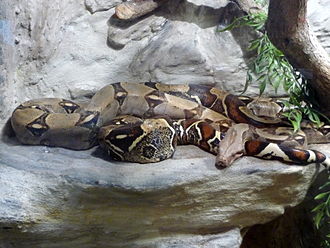The boa constrictor (scientific name also Boa constrictor), also called the red-tailed boa or the common boa, is a species of large, non-venomous, heavy-bodied snake that is frequently kept and bred in captivity. The boa constrictor is a member of the family Boidae, found in tropical South America, as well as some islands in the Caribbean. A staple of private collections and public displays, its color pattern is highly variable yet distinctive. Four subspecies are currently recognized. This article focuses on the species Boa constrictor as a whole, and on the nominate subspecies B. c. constrictor.
Though all boids are constrictors, only this species is properly referred to as a "boa constrictor"—a rare instance of an animal having the same common English name and scientific binomial name.
All subspecies are referred to as "boa constrictors", and are part of a diverse group of New World boas referred to as "red-tailed" boas, comprising species of both Boa constrictor and Boa imperator. Within the exotic pet trade, it is also known as a "BCC", an abbreviation of its scientific name, to distinguish it from other boa species, such as Boa imperator or "BCI."
Other common names include chij-chan (Mayan), jiboia (Latin American), and macajuel (Trinidadian).
Several subspecies of Boa constrictor have been described, but many of these are poorly differentiated, and further research may redefine many of them. Some appear to be based more on location, rather than biological differences. Boa imperator, Boa nebulosa and Boa sigma have been elevated to full species status.
| Scientific name | Taxon author | Common name | Geographic range | Etymology |
|---|---|---|---|---|
| B. c. constrictor | Linnaeus, 1758 | red-tailed boa | South America | |
| B. c. longicauda | Price & Russo, 1991 | Peruvian long-tailed boa | northern Peru | |
| B. c. occidentalis | Philippi, 1873 | Argentine boa | Argentina and Paraguay | |
| B. c. ortonii | Cope, 1878 | Orton's boa | South America | The subspecific name ortonii is in honor of American naturalist James Orton. |
Several other subspecies have been described at different times, but currently, these are no longer considered to be subspecies by many herpetologists and taxonomists. They include:
The boa constrictor is a large snake, although it is only modestly sized in comparison to other large snakes, such as the reticulated python, Burmese python, or the occasionally sympatric green anaconda, and can reach lengths from 3 to 13 ft (0.91 to 3.96 m) depending on the locality and the availability of suitable prey. Clear sexual dimorphism is seen in the species, with females generally being larger in both length and girth than males. The usual size of mature female boas is between 7 and 10 ft (2.1 and 3.0 m) whereas males are between 6 and 8 ft (1.8 and 2.4 m). Females commonly exceed 10 ft (3.0 m), particularly in captivity, where lengths up to 12 ft (3.7 m) or even 14 ft (4.3 m) can be seen. The largest documented non-stretched dry skin is deposited at Zoologische Staatssammlung München (ZSM 4961/2012) and measures 14.6 ft (4.45 m) without head. A report of a boa constrictor growing up to 18.5 ft (5.6 m) was later found to be a misidentified green anaconda.
Boa constrictors generally live on their own and do not interact with any other snakes unless they want to mate. They are nocturnal, but they may bask during the day when night-time temperatures are too low. As semi-arboreal snakes, young boa constrictors may climb into trees and shrubs to forage; however, they become mostly terrestrial as they become older and heavier. Boa constrictors strike when they perceive a threat. Their bite can be painful, especially from large snakes, but is rarely dangerous to humans. Specimens from Central America are more irascible, hissing loudly and striking repeatedly when disturbed, while those from South America tame down more readily. Like all snakes, boa constrictors in a shed cycle are more unpredictable, because the substance that lubricates between the old skin and the new makes their eyes appear milky, blue, or opaque so that the snake cannot see very well, causing it to be more defensive than it might otherwise be.
